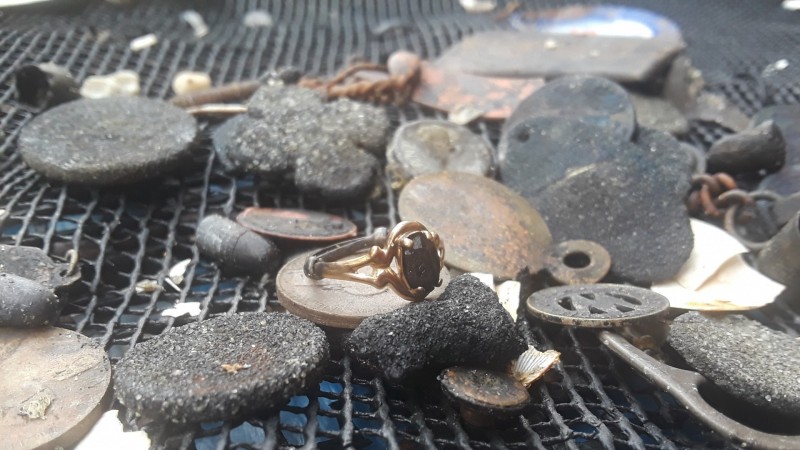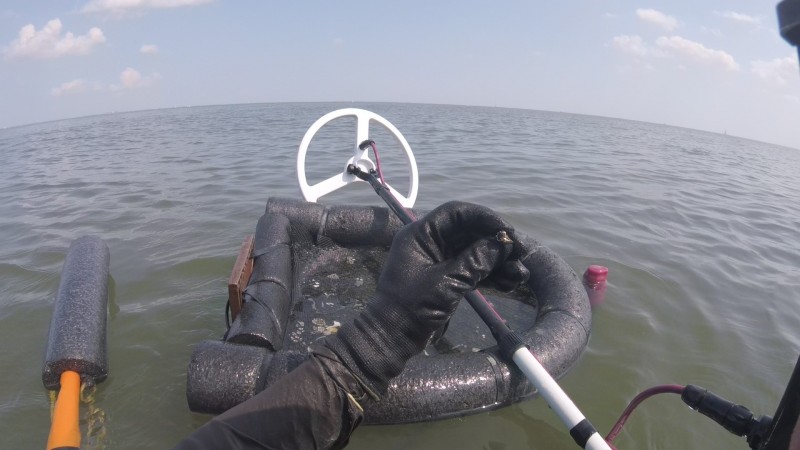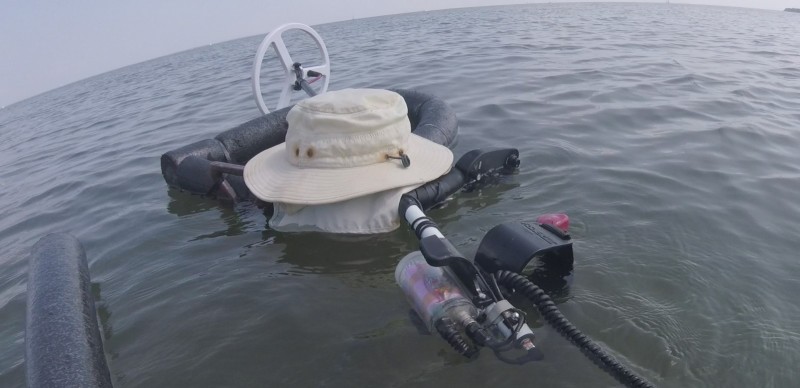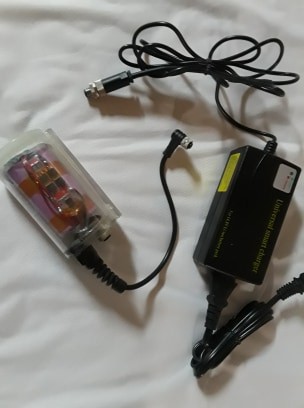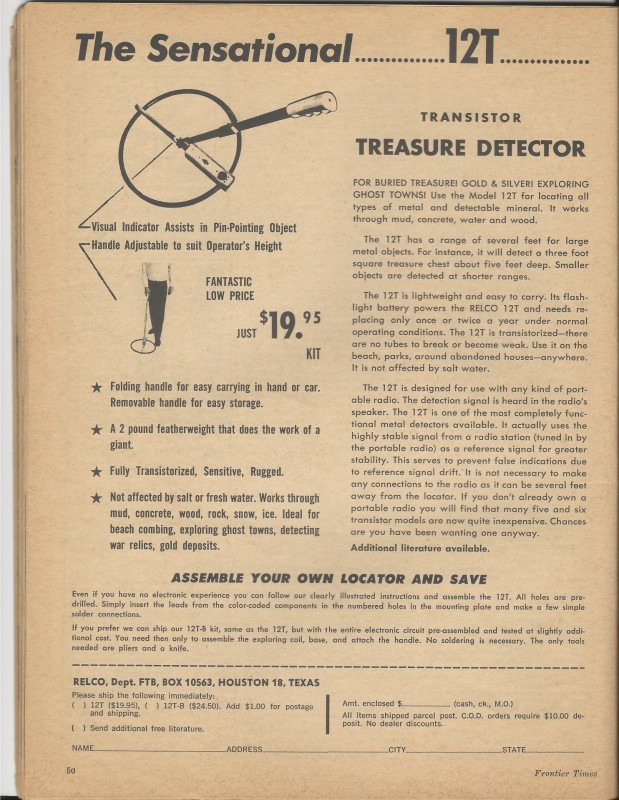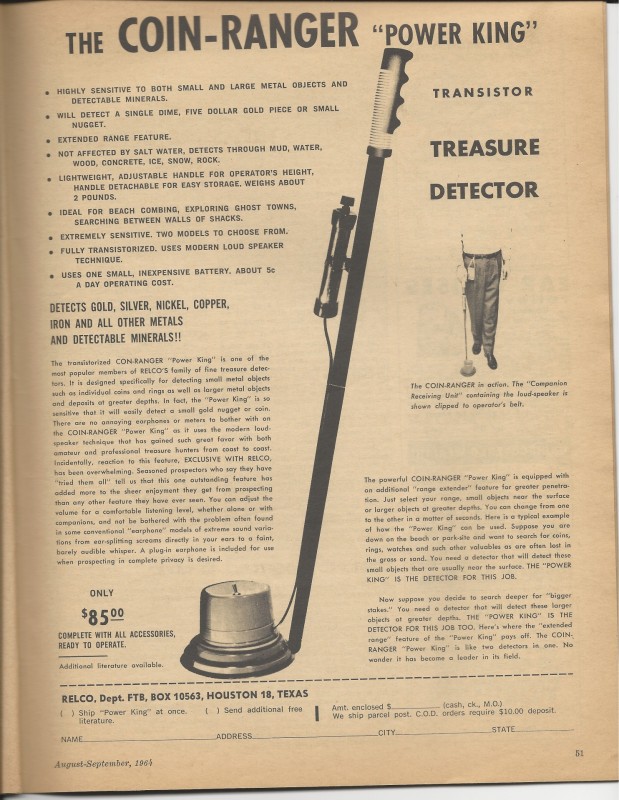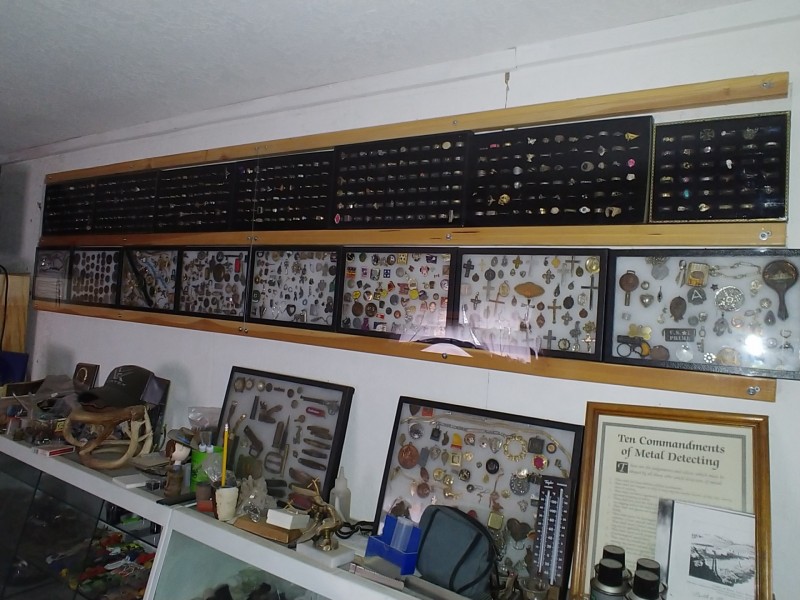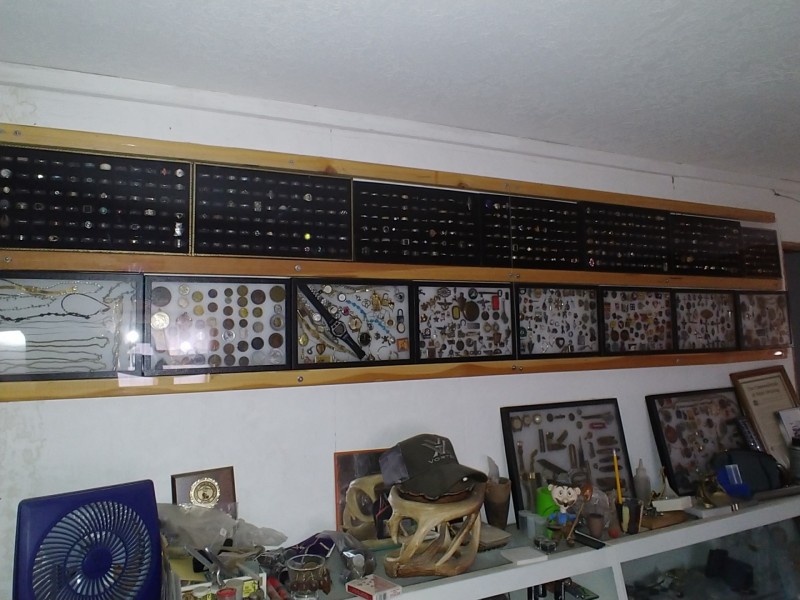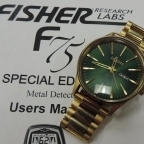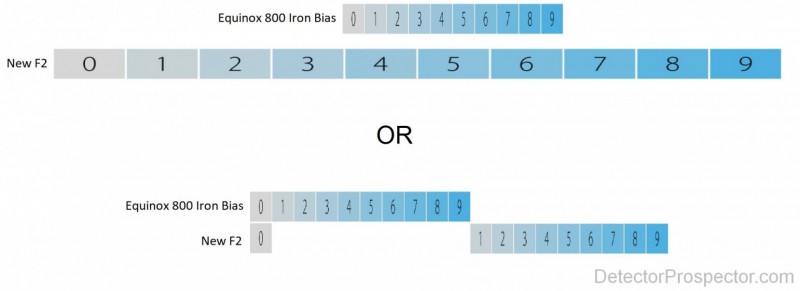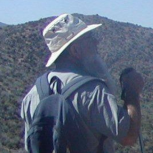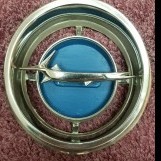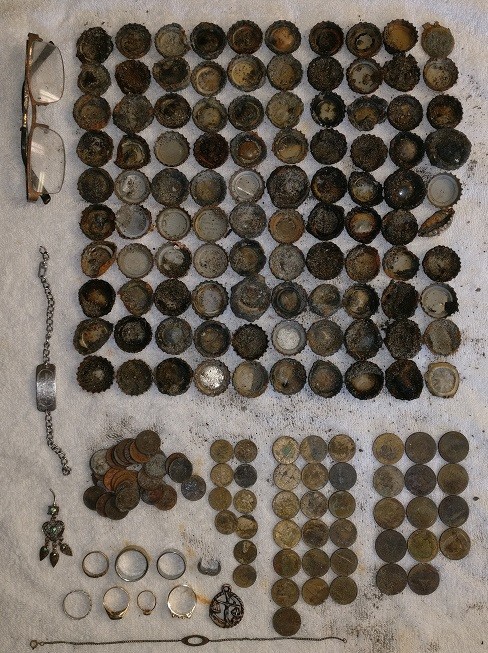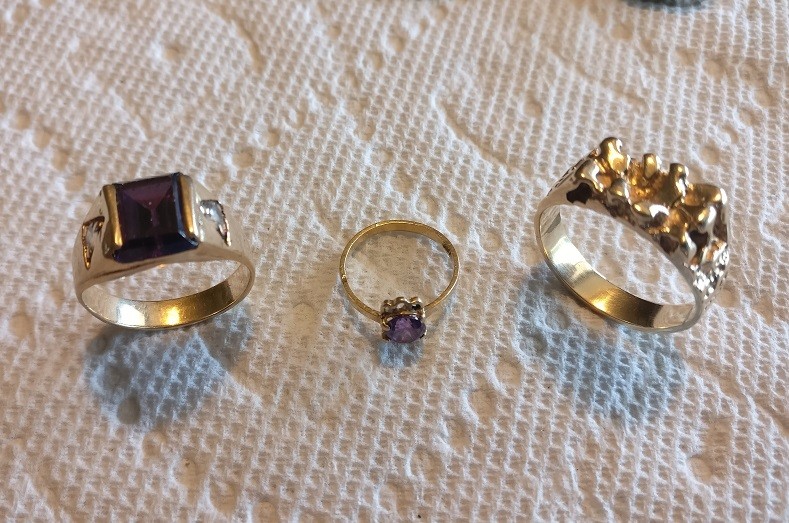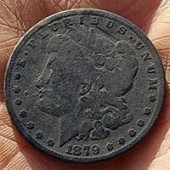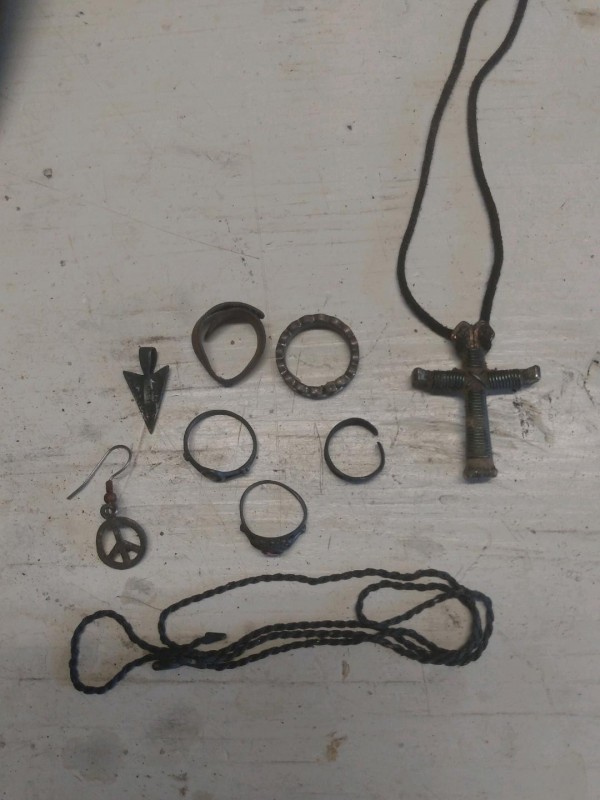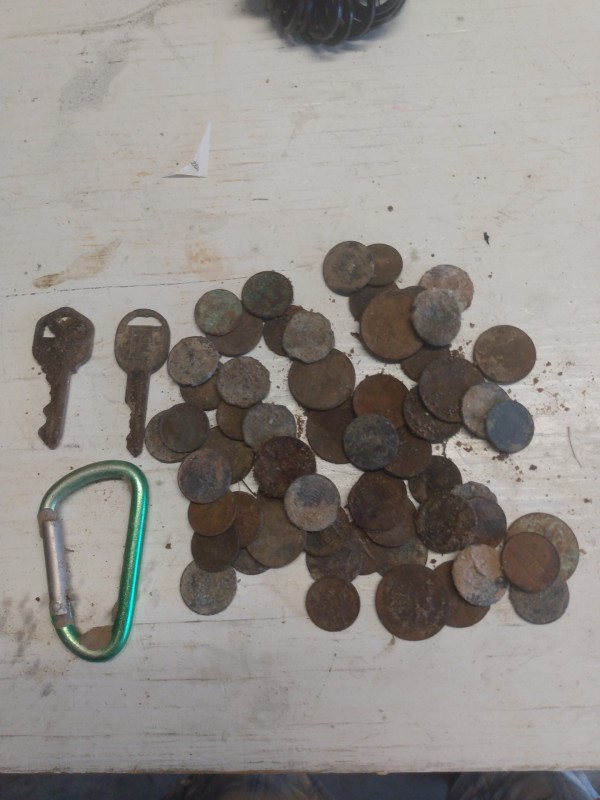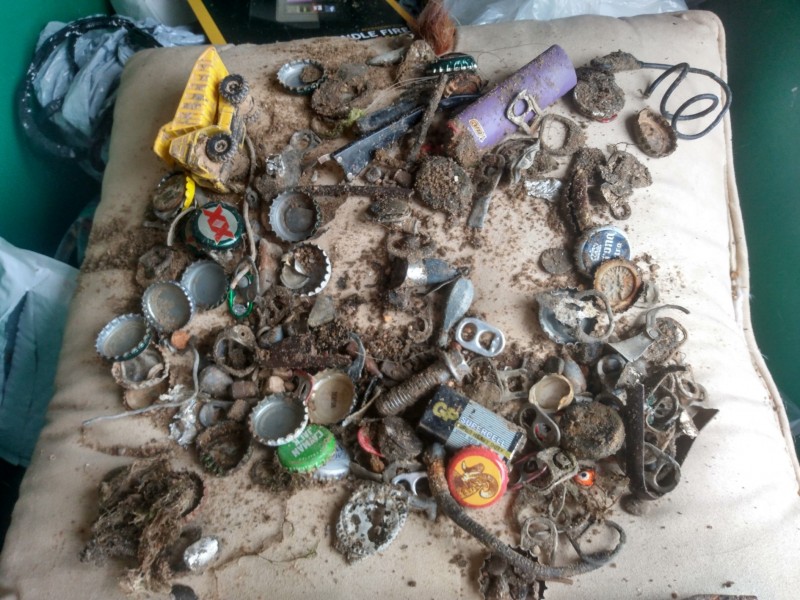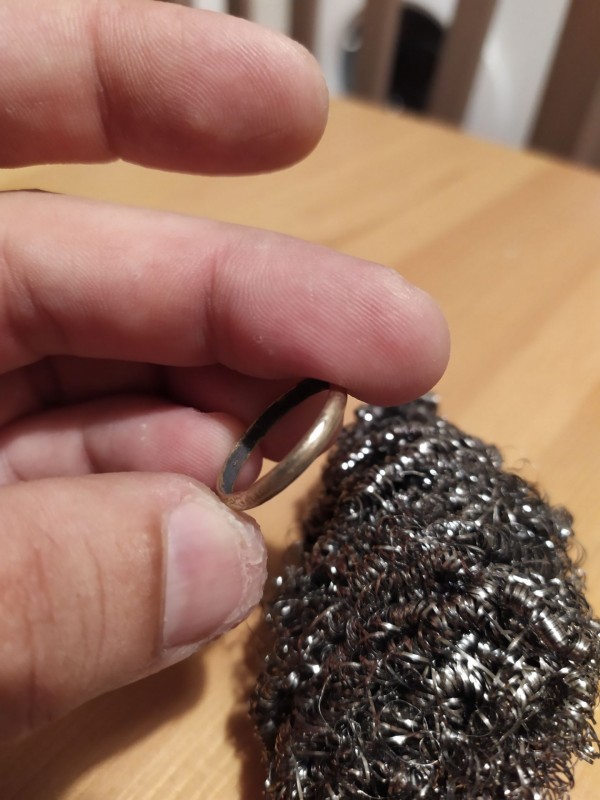Leaderboard
Popular Content
Showing content with the highest reputation on 09/09/2020 in all areas
-
Small gold ring from Last Friday using the AQ....Got 2 more gold Saturday but they were at a different beach and the excalibur. I'll post them later this week. Hit a bump in the road Sunday night, had to take a family member to the hospital ..she was in for few days and came home today... Thank God..all went very well. I was out twice last week with the shorty battery and it is now packed up and ready to go a few rounds with my friend Carolina...Give him a week with it and see what he has to say...I want his confirmation on the run time of 5 hours and 30 minutes and see if I need to make any adjustments...before I sell a few. Got rid of the m-8 headphone fitting and the battery is fitted with a M-12 8 pin CTX head phone fitting..(Very Common) and replaced the M-8 4 pin on the battery with a 90 degree molded cable that goes right to the end of the white shaft 4 pin power/headphone plug...So we got it down to One M-8 fitting..which the 90 degree is a Bulgin molded SS fitting..so it does not stick out like the stock...22 points
-
Agree. We are now probably talking about two completely different approaches to iron bias. EL NINO77's results tend give FE worse separation and Steve's results tend to give FE less "effectiveness" vs. F2. If EL NINO77's results hold, then that is a real eye opener regarding FE. Almost as if ML's first attempt at iron bias was severely flawed. The other thing that is flawed and as recently mentioned above, is why not a detailed Treasure Talk article on how to properly apply iron bias (both types) and when one might be preferred over the other and the plusses and minuses of cranking the magnitude of the IB setting. They obviously put some effort into refining IB, it would be great if they explained it better and in more detail.. Also, to emphasize the implied preference of F2 they should have implemented it in a manner such that it could be cranked to "go to 11". That would make F2 "two better" than FE.5 points
-
After reading many sad recollections of White's Electronics and the lamenting of the state of metal detector companies I was wondering what things were like back in the beginning. I happened to see and subsequently acquire the Annual Treasure Edition of Frontier Times Magazine issued in September, 1964. Although you need to go back to the 19th Century to find the real beginning, this is about the time that metal detectors became both portable and affordable (thanks to the recent development of low cost solid state electronic components -- transistors and diodes). In addition to five full length articles, here's a summary of the ads (full page all the way down to 2 line classifieds) in this issue relevant to the general topic of treasure hunting: Published materials -- 25. Build-your-own instructions -- 1, Panning, sluicing, etc. -- 3, Multiline dealers -- 3, Clubs -- 2, Scams -- 5. Besides those, here's a listing of metal detector manufacturer ads with state of location. See how many you recognize -- order is as found paging front to back: Raytron (CA), Relco (TX), Fisher (CA), White's (OR), Metrotech (CA), Art Howe & Co (KS), D-Tex (TX), Gardiner (AZ), IGWTT (NM), Goldak (CA). (Carl probably has at least one from each company. ) The only one of these with an ad of any size (second largest was D-Tex's 1/4 page) is Relco's two page spread shown here: Noteworthy in its absence is Garrett. According to Charles's 2015 obituary, the company was formed in 1964 so they were likely still a year or two away from their first ad. Adendum: I've added a scan of the White's ad later in this thread. The very small Fisher ad showed (in tiny drawings) part of a modern style detector and a 2-box, but hardly any detail.4 points
-
Photo from both ends What do you do with this stuff from years of detecting. All the gold and silver & diamond jewelry was sent to a refinery and provided me a few thousand dollars spending money, Have a lot more jewelry that is not displayed as there isn't any more room. Hundreds and hundreds of keys and tokens. this is just some of my finds over the years. March box cars, civil war relics from VA. Guess I just leave it and let the kids sort it out.4 points
-
Spent a lot of time in East Idaho back in this shaft right in the middle of good gold country. shaft goes back some 200 feet with a short drift here and there. Huge seams of quarts all thru this place. Don't know if the old timers found anything in here as I sure didn't. Did get one hit in the wall using GB2with 6" coil (no quartz)and tried to chisel it out with a small 2lb hammer and east wing rock chisel but no go. Nothing outside in the tailing pile other than blasting caps. They had to be chasing something. Is a real nice area with good gold 70 ft away in creek bed.4 points
-
You dont need to be on or near bedrock necessarily. Some of the best detecting patches out there are not on bedrock. Its just in the mix and float.4 points
-
Back several years ago I used the minelab Xterra 50. It was the first unit I ever used with a DD coil. I bought the 10.5 inch mid freq coil and the 6" 18khz small DD coil. It was an absolute blast coin unit. i had a ton of fun with it and found a lot if good coins and some of my favorite coin finds as well. Then I got the MXT with the 6x10 DD coil and had even more fun coin shooting. I used the mxt for Everything for a long time. My friend got an Xterra 70 and I tried it out thinking it would be like the 50 was to me years ago. I just could not get back into the target id numbers again if the minelab Xterra. I guess that is why I cannot get into the equinox numbering system. Yes I know it is an easier format somewhat but the target ID of the equinox crams a lot of stuff into 1/2 of the number system to me of say a 1-99 system. I guess I am just more used to the 0-99 like White has also Teknetics/Fisher and XP. It just makes more sense to me.4 points
-
Contact your local historical society and donate to them with the local finds. As for out of state do the same. They will gladly take and document, with your help in describing and where found. As for rings and things like that, It's tough to get more than scrap value, unless you have a lot of time on your hands trying to sell them on flea bay and such. Sometime kids do not make great choices in figuring things out. I had a friend who had an amazing early winchester rifle collection, That was worth in excess of $500K. His children didn't know guns, and after his death sold them all to a local gun shop for $25K thinking they made a pile of money. If you have concern's and love for your finds, Without monetary gain. Please donate them to a museum or historical society. That way future generations will get the same excitment that you have for each item. That's what got me started in my love of American History. Good Luck4 points
-
The Fisher engineer responsible for the Coinstrike/GoldStrike/ID Edge/Excel was a man named Dimitar....the same engineer who is now independently making the MDT-8000 that Tom Dankowski is such a fan of. The CoinStrike has no CZ Quicksilver DNA and none of the CZ coils will interchange with it. It was a completely new series of detectors that for some reason never really took off. The CoinStrike was designed primarily for hot ground and dealt really well with it. I dug lots of deep dimes with it in ground where they normally moved across to iron id at about 4 inches but the Coinstrike kept them in the non-ferrous range. One that really stands out in my memory was a good 8" deep and was reading a 42 with a high tone. A normal dime is TID of 28. On a regular VLF this would have already wrapped around to iron and been giving iron tone grunts. But the CoinStrike has an extend high conductive range that allows it to hold high conductors in the high conductive range longer. It also has a 99 point iron range so in the worst of dirt that just flings high conductors across the FE barrier, you can still identify them once you learn the ferrous number.... It also has a very mellow audio at depth. The folks that really got into them often told of elbow deep holes, mostly true, but disbelieved by the general public. The Key was ground balance and learning and being consistent with the sweep speed it liked. It was also pretty good on low conductors and it was great in iron, both large and small but really great in large iron.... Guess who just talked themselves into another one....HA! I teased up some nice gold rings with . Here is a helpful webpage.....http://home.insightbb.com/~johnhetti/coinstrike/ HH Mike3 points
-
The V3I has always been a all time great Jewelry machine......with good wide TID The ORX can be a great Jewelry machine .....just put the control box in your pocket and concentrate on good repeatable mid tones (sound only) . And you will clean up the soccer fields in no time.3 points
-
My first pick for an Old coin hunting tool would have to be the Etrac. It seems to manage my ground mineralization better at depth and I can sweep it extremely slow with good audio tools to pull them up. My second pick for Old coin hunting in my ground would be the Fisher CoinStrike as it holds the coins in the non-ferrous range longer in hot ground than any other VLF every made. Takes a bit to get the required sweep speed down but it really does very well in high mineral dirt. HH Mike3 points
-
I just got my Equinox 600 and unboxed it, charged overnight and went out in the yard to give it a try. I had the same issue I had to lower the sensitivity to 8 or less. Then it hit me I have an invisible fence to keep the dog in the yard. I went in and unplugged it and tried again. Now I am able to run up at 20-22 on sensitivity and it seems to be working ok in Park 1. I do have a bunch of junk in my yard as it was filled when the house was built and has lots of screws ,nails, bottle caps and scraps of metal but I guess this will only make me a better detector in the long run knowing how to deal with all the junk.3 points
-
Could be. Trying to integrate/correlate the old FE settings and new FE2 settings may be a waste of time. They could be using two different methodologies and are therefore just two different things. I'm sold on FE2, especially after EL NINO77s comments on separation effects. Assuming one is going to use Iron Bias, is there any reason at all to use the old original version? In theory it has a finer gradation of adjustment, but is that of any actual value?3 points
-
For several years now I have been dragging my buddy to new places that I thought would be good spots to detect. We both have darn little to show for all our effort. To make up for it, I got a well known nugget detectorist to take us into the field for some lessons. Here are three important take-aways from that trip: 1) High hills in old burn areas are great places to identify new nugget fields. 2) He showed us such an area where there were a great many very small-scale mining features that were invisible In Google Earth, yet the burn made them quite visible from a hilltop. Our guide said that based on his detecting experience, there were many more overlooked gold pieces to find here and in similar areas. 3) It can be easy to recognize the presence of hidden pockets in old burns by the discolored downhill soil these pockets shed. He said this was a common occurrence, and even if they have been mined historically, there were still gold pieces to be found in these places, but again I couldn't see a thing on Google Earth. He's a great guy, he's very knowledgeable, and he's expensive. I don't have his permission to list his name here, but he may added it at some time. EDIT: He said I can use his name. It's Ray Mills of Redding, California. His online name is AUTrinity.2 points
-
If I had a relative that showed some interest, I'd give the items to them. Otherwise, historical items to a museum, if they wanted them. Most of the time, unless it's a fantastic find, they won't want them, as, they have drawers of good stuff they don't even display. More common items that are too good to throw away I'd take to a swap meet and sell them. People will buy anything if the price is right. Donate whatever doesn't sell to charity and take the tax writeoff.2 points
-
I probably got this backward. I did say in the earlier post (asking Steve about the new matching of the scales) that I was having trouble correlating the two. I guess I felt I needed to confirm that further! Good points and good question. I think I'll play a little bit in the backyard teststand. Maybe I can get even more confused (but hopefully not drag you along with me). I'll just use crown cap(s) since those seem to be among the most impacted, and in general most common/prevalent targets.2 points
-
I have just resurrected my DFX and the 10x6 coil again are it went into retirement after nearly 15 years of use as when i started using my Deus 8 years ago and Nox 15 months ago my finds rate dropped like a brick,they still have found me some nice finds dont get me wrong but not as consistent as say my DFX and my other all time favourite the original T2. I have 3 other Whites machines including a TDI Pro which if i am honest dont get used as much,the TDI Pro i would class as brand new i highly doubt that anyone could tell the difference from one that had just come off the production. So although they dont and i highly doubt that they will start up again the DFX is still one of my favourites and will be used with the T2 gain as the 2 main machines,and i suspect my finds rate will also rise up again.2 points
-
When I hunted a lake thinking I was in f2 but was in fe I dug over 50 caps even in fe-9.I corrected my mistake after by putting it in f2 -7 and the caps sounded bad an I could tell they were caps to a high degree.I don't use the fe setting anymore.I hope they come up with a new FI setting that would rival the Deus in very thick iron.We would have fe,f2,and fi for iron bias.2 points
-
Oh ok I thought it was fixed with the HF coils and the deus. I guess I got confused with manuals!!! So that's why I couldn't figure it out!! Thanks everyone!!2 points
-
Hadn't heard that conspiracy theory before 🤔 The HF coils were introduced more than a year and a half before ORX (if you ignore the Orx immediate ancestor, the Depar DPR 600 - but that was more like a Deus with only Gold Field, was even compatible with the WS4/5 phones and came with an HF coil). XP can easily "fix" this with a SW update to Deus, but has chosen not to for whatever reason. I think it might be the other way around, actually. The Orx was probably designed around the HF coil even though the coil was initially developed for Deus/Depar. I think the fact that ID norm is fixed for all coils on Orx is simply a matter of simplification for the end user. Just another setting the end user doesn't have to fiddle with. That's my take anyway. That being said you just might be right, Jeff. You referred to Orx ID normalization of all coils as "more proof" that the HF coils were designed for Orx. What other evidence do you have that this might be the case. Cool little tangent I hadn't given much thought. Thx.2 points
-
Ditto from me on the Nokta/Makro Multi Kruzer. Lightweight, good target IDs, easy to use, nice readable display, good wireless headphones. Great overall package. I use three tone in a really trashy park to pick out good targets, and four tone if not so much trash to search deeper.2 points
-
Well I can't say enough good things about my Nokta Multi Kruzer. This is a great solid coin machine (sometimes too good). Clad, silver and gold you won't guess at whats under your coil. I've had it for roughly 8 months, And have found around $1100.00 in face value and scrap coins. My second choice would be my lowly Tesoro compadre.2 points
-
Just FYI - With Equinox you have to GB separately for each mode and also, you could also GB separately for each single frequency used if you are still hearing ground feedback. But what you are experiencing is not ground noise due to out of whack GB but it does sound like EMI, as you surmised. Once you go to single frequency, the multifrequency mode profile (e.g., Field 1) disappears and all you are left with is the models default or user adjusted settings. (Disc, tone settings, and recovery speed settings) associated with that mode. IOW 5 khz in Field 1 will behave just tge same as 5 khz in Park 1 save for the mode associated tone and recovery speed settings. Note that there is no iron bias filter when in single frequency. Nope. It usually goes as you describe with the lower single frequency settings being more susceptible to typical generalized EMI. The exception is 4khz with the newest software update which appears to run a tad quiet than 5 khz. There are of course exceptions to this for specific narrow-band electromagnetic noise sources or strong emitters like invisible dog fences. You are probably getting bombarded by multiple sources of EMI - power lines, cell towers, a nearby cell phone, residential WiFi, other radio transmitters, fluorescent light ballasts, etc. All those sources interfere with each other and create local maximum and minimum noise fields. Furthermore you detector is affected by RF noise picked up by the coil acting as an antenna and also noise that is directly absorbed by the microprocessor electronics in the control head (nearby cell phones are the typical culprit in the latter). Finally, time of day affects load on the power lines (how much current is flowing) which translates into time dependent noise generation. Finally, he degree of humidity in the air can have a variable effect on noise levels as well as lightning discharges. Try re-running noise cancel if you change frequencies. HTH.2 points
-
So I was just practicing and testing with the detector again. We tried another lawn, first we did noice cancel and ground balance. Then we took Field 1, held the detector with the coil down and had it still, it sounded a lot, the same when we held it in the air, so I guess it was EMI interference. But we changed the sensitivity from 25 to 15 and it went well and gradually tried to all the way up to 21, no noise then and tried different frequencies such as 15, worked well. I then went back to the lawn I first wrote about which was problematic. I also first did noice cancel and ground balance, Field 1, but it sounded a lot of noise, but when I lowered the sensitivity to 15-16 it disappeared. When I tried to sweep it over the ground, it pepped sometimes and sometimes not, so that should be a sign that it worked well? It was the same on the other lawn. Something that surprised me was when I tried to put it in the ground and hold still and sometimes lift it above ground in the air, still Field 1, sensitivity 15, and it went well in 10 KHz, 15 KHz, 20 KHz and 40 KHz, no strange sounds when still with the coil in the grass, or still in the air. But with the same sensitivity 15, it made a lot of noise at 5 KHz and in multi mode. That it would make more noise in the multi mode I had expected, but that it would make a lot noise in the 5 KHz mode surprised me. Shouldn't it be the other way around, that 40 KHz makes the most noise, 20 KHz less and 5 KHz the least? Only when I changed the sensitivity to 11 did the 5 KHz stop making noise when I held it still, while the multi mode stopped at sensitivity 13. How can that be, should not 10 + KHz be more sensitive to EMI than 5 KHz? So the higher the frequency, the more sensitive to EMI? But here the lowest frequency, 5 KHz, seemed to be the most sensitive and made noise while the others (except multi) were silent. How can that be? I was maybe 50-70 meters from the powerline, when testing, but in addition, I went closer to the powerline, and tried to stand almost below the powerline just som meters from it, and it did not seem to give any EMI when I tried with 15 and 20 KHz, with sensitivity 15 and some higher. It seemed that there was less EMI, the closer I got to the powerline. Does that seem strange? Maybe it was something from the two houses by the lawn that disturbed the most, maybe satellite or similar? Maybe the frequency in the powerline right now was weaker today maybe?2 points
-
When I talked with the responsible archeologist for the county two years ago he asked me what will happen to all those finds if hunting season is over!? In most cases the family is unloading all the "trash" to the dump. If one member of the family has interest in coins and jewelry these will find a good home, otherwise it will be sold. Back home I talked with the wife and the kids and we decided to collect some rare coins and nice jewelry and sell the unwanted stuff... but all the historical finds like tags, coins, buttons, buckles, harness-parts and so on is given to the state office for archaeology once a year with a finds-report. So there are no boxes full of stuff taking space and the historical stuff has a place in a reasonable area. IMO1 point
-
I hunted a new (too me) spot yesterday for a couple of hours from ankle to chest deep water, settings were all metal mode, delay 10, sensitivity 8, and ATS 5. The detector ran well with some chatter but nothing overwhelming and similar to my TDI BH, it's probably a given as with other detectors that I find how the AQ runs differs from beach to beach and can sometimes be run hotter or has to be turned down. Anyways near the end of my hunt is when I found the gold ring, it took a few scoops to retrieve it and I would guess it was in the 10" range, at first glance I thought it was a junk or gold plated ring being that it is tarnished on the inside. After getting back home and assuming the ring was junk I didn't bother to look at it until later in the evening and upon inspection could see a 14k stamp inside the ring, I then tested with my GXL-24 Pro gold tester and it displayed 14k, this tester does distinguish between gold and gold plated/filled items. I've never found a gold ring that looks good on the outside but tarnished on the inside like this before, any thoughts or comments? BTW the ring is 7.0 grams, also can't seem to edit title to show AQ instead of Aq.1 point
-
Yes, but also seems like in some ways they've come full circle. The 12T model (12 inch diameter coil?) weighs in at 2 lb, has all the custom electronics attached to the coil, and relies on an external receiver ('transistor radio') which you carry in your pocket. OK, does that remind anyone of a particular modern detector??!!1 point
-
Thanks Buddy...👍 Thanks mn90403....That is a transit token...Washington DC..I did have a nice collection of them from several different companies but ended up sending them down the road..Not worth much other then conversation piece.1 point
-
Hey all, So here's my question!! Sounds like a variety of great coin machines that everyone had, or has!! But are they in use? Or collecting dust in the corner, or sold?? And has this post inspired anyone to pull one out that they still have, and crank it up for a hunt again?? Sounds like it's about time for an old detector shootout!🤣👍👍1 point
-
Sorry....No. no DD coil was every produced for it. They made a 6" concentric, an 8" concentric and a 10.5" concentric. But no DD was ever produced for the Coinstrike. One other feature that was helpful in iron was that that it was very fast, but when you didn't need the speed you could turn "averaging" on. It would give a aggreate average TID response when turn one. Very solid lock on. It's kryptonite was steel bottle caps. HH Mike1 point
-
1 point
-
Congrats on the sweet gold ring and your success with the AQ detector OBN! The silver is impressive as well.1 point
-
This is in Idaho. I still do a bit of gold detecting but not like I used to. Sold all my gold and bought guns.1 point
-
When I coin hunt it's usually only for older coins. So I want a metal detector that can not only go deep but have an accurate ID at depth in my bad soil. Equinox 800 fits that bill for me, nothing else but a FBS machine can come close.1 point
-
I did some field testing yesterday in a particular very iron trash rich ~ 20 sq. m. section of a park I've been hunting for five years. Every IB/VLF detector I own has gotten at least a short workout in this spot. The first couple years I found the good targets (including a Mercury dime and an Indian Head penny), but since then it's difficult to even find non-ferrous. I always use this for a tough trashy iron workout and thus playing with the Equinox 800's Iron Bias feature, it seemed like the right place. Here are the settings used: In retrospect I should have done a ground grab on all four modes. I was not getting any ground noise from any set at 0 so just left them there. My procedure was to set all modes at F2 = 0, search in Park 1, and then investigate in Park 1 with F2 = 9 as well as other modes at both F2 = 0 and F2 = 9. Here is a photo of the targets I eventually dug after doing those investigations: Now I list those targets, noting how they sounded and what visual TIDs' they showed: 1) ~3" deep bent aluminum clip (lower center of photo) -- gave a bit jumpy TID around 17 in all four modes. All gave mainly clean signals regardless of FE2 setting (0 or 9). I did notice that in Park 1, FE = 9 that I got more iron noise from surrounding weak targets, but there wasn't any confusion given the size and depth of the aluminum target. 2) ~7"-8" deep aluminum foil -- (Note: this target was likely all in one piece but it broke during recovery. I tried to remove all of it but possibly a few shards remained in the ground.) All four modes showed TID's of 7-9 and all sounded good (no iron confusion) at both F2 = 0 and F2 = 9. 3) unknown deep target -- (Note: I've been fooled by this target so many times that I now know it's location, but I wanted to see what IB changes would do. From multiple recovery tries -- not this time! -- I get down about 10" and handheld pinpointers tell me there is still more distance (> 2") to go. Recall I'm in a park so I don't want to dig a grave.) Park 1 gave a consistent 40 TID with no iron sounds at all. The other modes gave 39-40, also without any iron grunts. Strong and seemingly localized signal. Short of someone burying a silver bar there I suspect it's a large piece of iron farm equipment. This once was part of a farm lot and I've found many pieces of discarded farming tools, etc. When I switched all modes to F2 = 9 they still gave no indication or hints of grunting and kept the same TID's. 4) ~6" deep, very rusty iron bracket (lower right item in photo. The picture doesn't show that the cross section is a flat rectangle, about 1/2" side by 1/8" thick.) -- Park 1 and Field 1 (IB minimized) gave target ID's in the low 20's. Park 2 and Field 2 said high teens. I only checked F2 = 9 for Park 1 and Field 2 but both gave noticeable iron grunting then but still showed (now jumpy with negative numbers occasionally mixed in) the same TID's as before. 5) ~3" deep, 5" long square nail near a ~2-3" deep bent, round cross section nail. (The distance between them was ~4"-5" and I got fooled into thinking this was a single target. The square nail was pointing towards the bent nail and I think its 'sharp' tip was giving the non-ferrous signal. The bent nail may have contributed to that, though.) Unfortunately I didn't record TID's other than noting that with F2 = 0, all gave mixed ferrous and non=ferrous. When I checked Park 1 and Field 2 (only) with F2 = 9, both just resorted to ferrous tones, no longer showing any non-ferrous. 6) vertical nail, tip up, with tip ~6" deep. All four modes gave TID's 19-21 without noticeable iron grunts. With F2 = 9 there was a hint of iron but the non-ferrous was still sounding good. (Note: I was never able to recover this so it's not in the picture. I just wasn't able to break the nail loose as its head was buried much deeper and I was digging in mixed crushed stone and soil. I was able to feel the tip easily with my bare hand so I know what it was, and estimate it's length as ~3"-4", possibly a 16d size.) For the other two targets pictured (~1" long finishing nail and a second bent nail) I didn't take notes sufficient to report. In summary, the two non-ferrous recovered targets didn't false much, if at all, with F2 = 9. However, they were pretty strong signals to begin with. Some of the iron (such as the rusty bracket -- item 4) did give more grunting with F2 = 9, but they were already showing that at F2 = 0. Still, an increase in grunting could help as long as it's for actual ferrous (as in this case).... The evil vertical nail, IMO, is not one that I would ever ignore at either F2 = 0 or F2 = 9. In my experience, vertical nails always sound good, especially if the head is up (not the case here). Bottom line is that my tests don't give Iron bias F2 a gold star for these common relic hunting trash targets. After performing this exercise I read Steve's post that the overlap of the two scales (original FE and the F2 that was included starting with update 2.x) apparently is different than previously indicated. If I understand the new comparison correctly it could be that FE could help better ID'ing the targets I recovered under those in-field conditions. I may have to do another experiment.1 point
-
Mxt is specifically a detector..because it does not have a manual ground balance ,, but it has excellent autotrac and also a locktrak ... If we talk about the identification of the signal of deep targets on Auto tracking ... you have to rely on what the combination Mxt + certain Coil can show.- on the side of sensitivity to small targets as well as in range and accuracy of ID on very deep targets-where also enough the indicator of the probability of iron also helps ... Mxt is a detector ... which can be very deep on various large and small coils .. it is about range + accuracy of ID and in this case I think that the coil Sef 6x8 is still the best ... even though 7 "coils Mars and Detech they are also very close .. Coils 6x10 Whites, 5.3 "CC Whites as I will have a smaller depth and ID range ... Even 6x10" Mars Sniper will already have a range ID less deep than coils sef 6x8 "and 7" Detech and 7 "coil Mars MD .. . And if Mxt has any reserves in performance in this area ... then it can prove it with a Coil of the so-called optimal size up to 8-9 "max ... Larger coils will bring a slightly increased range to deep targets ... but they can already lose some sensitivity to very small and also deep targets but important .... there is also a correctness-accuracy of the ID at the limit of range. Since I own 3x .... standard 10 "DD Whites, 2 x ..12x10 SEF, 13" Ultimate, and 18 "detech excelerator II... and from these coils it retains the best sensitivity to very small targets according to me 13" Detech Ultimate. . The weight of my s V rated 13 ultimate coil and cover is around 574 grams ... this is a very acceptable weight ..1 point
-
Those guys out of the Ukraine make quality stuff. I have bought their set for the T2 . Good quality stuff and worth the wait..... Believe it or not. I am leaning toward the 13" ultimate coil. I like the mxt and since your post the other night when you did your equinox trade.....I would up with another original mxt tracker myself. I also got another T2. What the heck an I thinking??? I too am going backwards. However both if the machines have good performance and are built pretty good. The reason I went back to older tech that took replaceable batteries is because of thought yo myself heck what if I had an opportunity to go on a detecting outing and i forgot to charge my XP stuff and I did not have 4 hours to wait for the stuff to charge?? That's why I got a couple of the old school units. So that is why I1 point
-
Simon, With all you post about what you do, i don't think anyone here, is ever going to label you as being lazy! I would take your definition of lazy any day!!😂👍👍1 point
-
That's a Great collection!! WOW! Unless it's Gold or Silver it goes, then the silver gets melted. I hate to say it but I give away stuff like that. One has a grandson that loves finding it in grandpa's yard...then some I return so others can find it...the stuff can add up so much the kids will just trash it..or give it away. My two girls know I keep the gold only so trying to make it easy on them... Very cool is a club member is up in his 80's and he has seeded hunts with his relic's, no charge to club members. One way to send it out for those who have no experience finding some of the kool things he has..1 point
-
Over the years i have built up a fair amount of detector and still own them all including Deusx2 and Nox etc but they still have not come close to what my faithful old original T2 has found me,infact its become my No1 everyday machine again.Never ever let me down and with the Sharpshooter coil has found me more gold coinage and silver hammered coins than all my other machines put together,the only other machine which comes close is the DFX which once again has found me the 2nd most gold coinage. I always make a mental note of what decent finds go in my finds pouch and its the T2 by a massive amount,its a funny old game this detecting lark when a simple to setup machine the T2 takes just seconds to fire up and be away detecting but machines like the Deus and Nox are not as capable in my mind........keep it simple works really well for me. The many other machines that i have these days mainly have specific uses like deep pasture hunts or very trashy roman sites but my T2 is my all time favourite.1 point
-
Went for an all-day water hunt recently and tried some different settings. I dug every positive TID for most of the hunt and wound up with over one-hundred bottle caps (threw some in the dumpster at the lake). I really focused on the TID's less than 20 and even skipped a few in the mid-twenties just to try a different approach and learn more about the detector. I dug every "1-4" trying to find another gold chain or bracelet but it was not to be on this hunt. There was a little more trash that is not pictured here so the overall trash to treasure ratio was about 3 to 1. Wound up with 3 gold rings (13 grams total) and 1 silver ring- the rest of the jewelry is cosmetic. I Instead of hunting in "Gold 2" mode like I usually do in fresh water I hunted in "Beach 1". The Beach mode is a lot smoother but not quite as deep as the Gold mode. This was a bit of an experimental hunt but wound up being pretty productive. I'm happy with the gold but I think that I prefer hunting the wet sand at the beach- it's a lot easier on the body! GL&HH!1 point
-
We didn't take a detector. it was lectures with explanations of actual locations.1 point
-
I love this discussion. What I find interesting based on Steve and Jeff's testing how little FE affects certain mixed targets. I think it is just tough to compare FE with F2. Perhaps they react differently to different types of targets. If I take Steve's latest theory on the FE to F2 scale comparison the following observations come to mind (which I am dubbing the Herschbach IB scale to differentiate it from the Dankowski IB Scale): 1. If FE indeed reacts so minimally compared to F2, I wonder why ML chose to retain FE other than to avoid complaints from Equinox users about removing desired capability. I know that personally, I have never invoked FE ever since F2 showed up in the Ver 2.X update. 2. Steve's theory might also support the notion that Fe 0 and F2 0 actually both represent completely turning off the IB filter. That notion sort of went out the window when I first embraced the "Dankowski IB Scale" that showed FE 0 ~ F2 4. 3. Finally, I find it interesting that ML took care to select different FE IB default settings for different modes including "0" for Park 2, Field 1, and Field 2 and 6 for everything else. And, counterintuitively, set the F2 IB default to 6 across the board. Hmm... BTW Using the 3.0 update.1 point
-
The chart was originally posted here created from information Tom Dankowski posted based on what he thinks he knows about the control. I’d say based on my simple test that the information is now suspect. Tom said the new FE2 vastly expands the control range both higher and lower, with the original FE setting spanning the middle of the new range. Tom is equating Iron Bias 0 with the F2 setting of 4 and Iron Bias of 9 with F2 setting of 6. However, in my video you can see that a FE2 setting as low as 1 has more effect that a FE setting of 9. The FE2 setting of 2 makes it very obvious. Based on my simple test it looks like a FE setting of 9 is more like a FE2 setting of 0.9 So is FE2 setting of zero actually applying less bias than the FE setting of zero? Tom says so, but my current answer is “I don’t know” until I create a scenario that proves it. That would mean a FE2 setting of zero would have to produce a nonferrous reading on a target that the regular FE setting of zero called ferrous. Right now that seems a poor bet since all FE settings appear to fall in the FE2 region between 0 and 1. Based purely in my video the FE settings of 0 - 9 appear to equate to FE2 settings of 0.0, 0.1, 0.2, 0.3, 0.4, all the way to 0.9 Or another way to look at it is that if the original FE setting tops out at FE9, then the FE2 setting of 1 would be the equivalent of FE10. None of this information about how FE and FE2 relate to each other is anything other than speculative and should be taken with a huge grain of salt. The only thing I know for sure is the FE2 range is far more aggressive than the original and kicks in earlier than I thought based on what Tom had said.1 point
-
IMO you can combine these two thoughts. Here's my hyphothesis. Iron bias doesn't affect surface non-ferrous targets, but as that item goes deeper the falsing (non-ferrous item sounding ferrous) starts to occur. The higher the iron bias setting the shallower that crossover occurs (for a given ground mineralization). There may be competition between the target 'disappearing' completely due to being too far from the coil (i.e. too deep) and the target (not so deep as to be lost but) sounding completely ferrous. Thus for deep non-ferrous you want the iron bias setting minimized. That's where it matters. I emphasize this is merely an hypothesis. I've not proven it (yet).1 point
-
Allen's great story of the commissioned search for that family's cache, reminded me of one I'll add here : There is a local dealer here, who has a rental model they rent out (an old 5000D series 1) . A person had rented it, but brought it back the next day having failed to find what they were looking for. They just didn't have the expertise, and were running into common junk where they were trying , etc.... They asked the dealer if he knew of any hobbyists, with more experience, that could help. The dealer referred them to me. I got the call , and asked what he was trying to find. He explained that about 10 yrs. earlier, he was going through a divorce and some hard times. He didn't want his coin collection to be subject to any split terms , so he had boxed it all up, put it into a plastic sealed tupperware tray. He took it to a buddy's house and explained that he needed to hide this "till the heat was off", and asked if he could bury it in his friend's yard. The friend agreed, and the two of them went to this guy's back yard (nearly an acre in size) and buried it. They made mental note of which bush it was near, and paced off the # of steps from a nearby fence, so that they'd have place-markers. Years and years went by. During that time, the homeowner did a lot of garden work in his back yard. Planting new shrubs, moving others, etc.... He also updated his fence. Finally, about 10 yrs. later, the friend came back to get the buried coins. But lo & behold, every bush seemed to look alike. And the fence post they had made mental note of, was no longer the same fence post arrangements. So the two men just started digging random holes in the area that they best recollected from that time 10 yrs. earlier when they'd buried it. To no avail. So they rented the detector. But were in for a rude awakening : The homeowner had installed gopher wire (like chicken-screen substance) around all the tomato plants and such. They got a few typical garbage signals from the yard (aluminum, etc...), but simply didn't know what they were doing. By this time, there were now holes all over the yard. I asked the guy how many coins, and what type he had buried. He described it as 50 or 70-ish gold coins, all together in a cigar-box sized tupperware container. And said he recalled that they buried it no-more than 2 ft. deep. My immediate thought was that this should be child's play. But after a few hours hunting with my standard detector, I was coming up empty handed ! Unbeknown to me, was that all the coins, even though in single container, were all individually in plastic sleeves. Ie.: not touching each other. Therefore, in the same fashion as a necklace, the detector will tend to see them as individual objects, not as a composite whole. The next day I came back, armed with a borrowed TM 808 2-box machine. After another hour or so, I finally got a weak beep. So weak that I almost figured it couldn't be the target (because I was still expecting a lunch-box sized signal). But this was it ! Once we got it out of the ground, and opened it to look at the coins, it was then that I realized why such an amount of coins, at only 2 ft. deep, was difficult : Because since they're not touching, it's not seen as one big signal. It's a more difficult signal, when they're not a continuous singular piece of metal. And the plastic container, of course, wasn't giving any signal. Wish I could say it had hundreds of gold coins like Allen's, but .... oh well 🙂1 point
-
1 point
-
Had a good hunt at the lake today, hunted for 6 hours and ended up with 5 pieces of silver, handful of clad and a pouch full of trash. 3 silver rings, silver pendant, silver chain and a couple of junk pieces of jewelry. Stayed on the dry beach today because the lake level is dropping. Ran the Nox 600 in Park 1... recovery 2... Iron bias 0 ...Sens 23 ..1 Tone, dug everything from 0 up.1 point
-
Long story short, I don't even know what machine I was using when I pulled it out from the bottom, but maybe months after, half an hour ago I was checking my Ctx for tomorrow hunt and testing some targets from my garbage/crusty/horrible coins can....When I passed it over the coil the numbers were all but obvious to be silver...So a 12.24 was lightning under my eyes and decided to give it a go for a steel wool run... I still need to clean well the Inside part of this oldie to the point I can barely see some engraving like a date or something... For now, I'm smiling like a child with a surprise...Gold has a terrible effect in my veins💀 It is the second time that I find something interesting but neglected...My daughter found a charm in the same bin😵....1 point
-
The salinity control is a filter. Increasing it helps reduce or eliminate some salt or ground signals. It can also act to reduce or eliminate some false signals from ferrous targets. It can also reduce or eliminate some low conductor signals. Lead, aluminum, gold. Eliminating a lot of aluminum signals may be an acceptable trade for the possibility of some lost gold items. It is a trade off based on your experience and basically a little bit of a gamble. It’s really not possible to tune out gold of large size with the salinity control, just more like what people would call micro jewelry. Losing some micro jewelry not to dig pounds of aluminum might be acceptable trade, with size you will still be getting the rings and other desirable and weightier objects. You could certainly get a good salinity balance for the beach while eliminating some aluminum. You really don’t get a choice. Eliminating the salt signal will take some aluminum with it, along with some gold. The gold/aluminum/salt range overlap, and affecting one will affect the others. What you can not do is tune out the salt entirely without affecting gold or aluminum in any way.1 point

.thumb.jpg.d71314a45f3dc82bf75ac1b96e7e9201.jpg)


